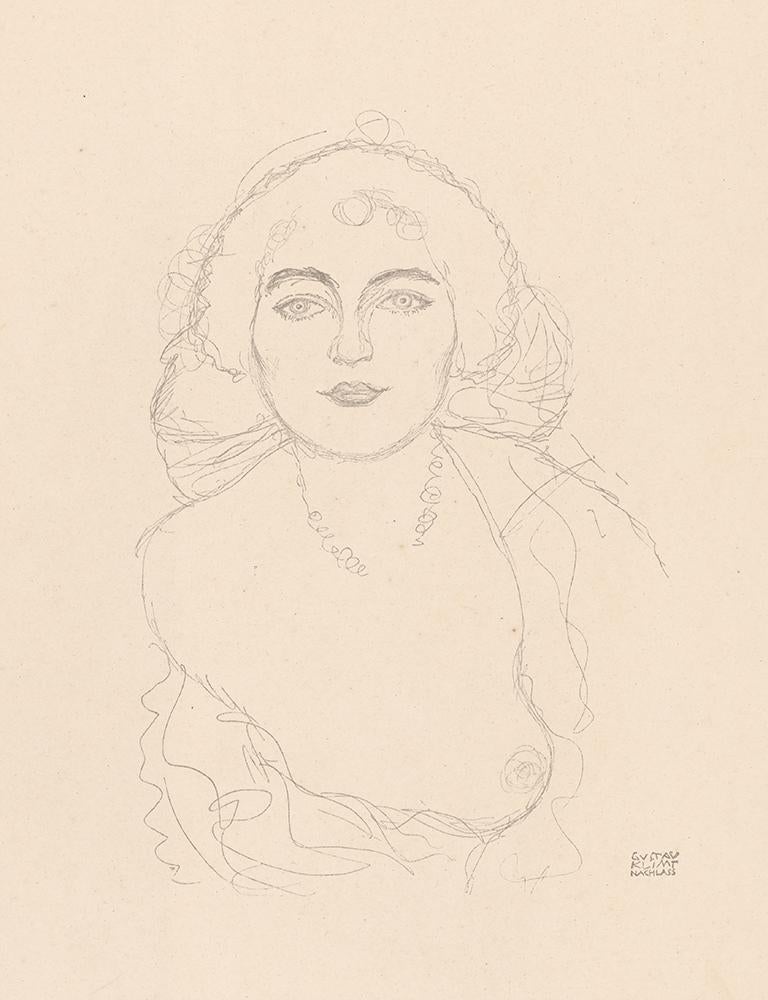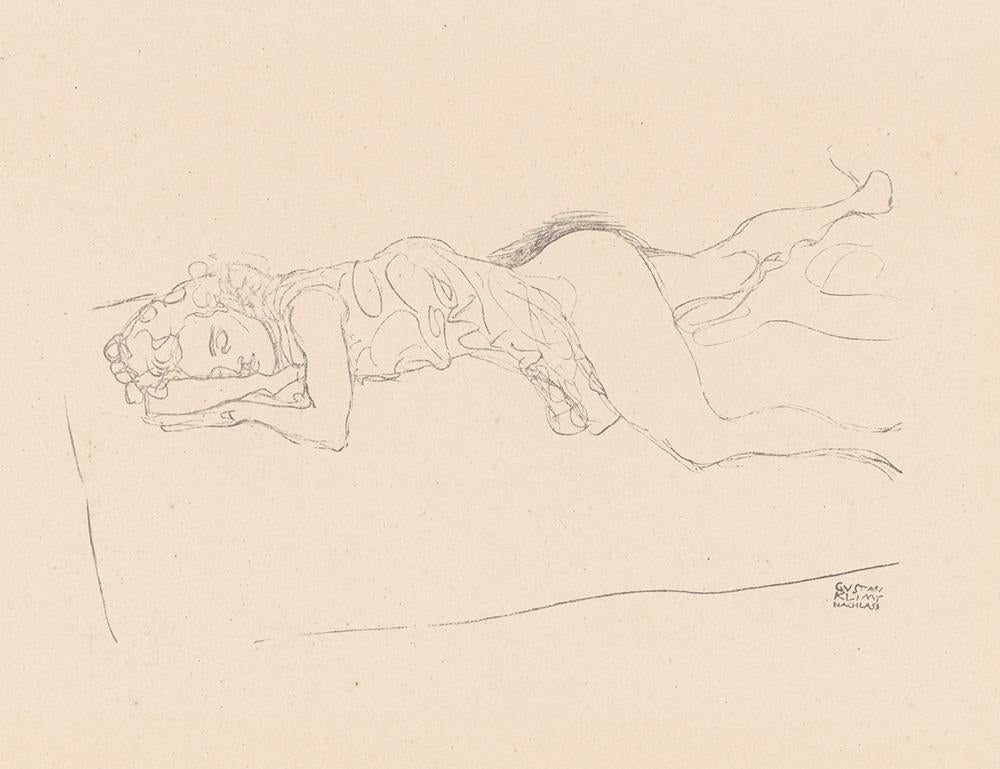Items Similar to Standing nude, Gustav Klimt Handzeichnungen (Sketch), Thyrsos Verlag, 1922
Want more images or videos?
Request additional images or videos from the seller
1 of 3
Standing nude, Gustav Klimt Handzeichnungen (Sketch), Thyrsos Verlag, 19221922
1922
About the Item
Original collotype lithograph of a figure drawing from Gustav Kilmt’s handzeichnungen (sketch) in 1922 by Thyrsos Verlag, Leipzig and Vienna, in an edition of 375. This artwork is presented in archival rag mat and arrives accompanied by a certificate of authenticity.
Klimt’s mastery of depth is most evident in the gentleness of his linework. Without the aid of shadow or the subtlety of values, the gestures of line allow the viewer a sense of a three-dimensional person or object. The meticulous lithographic process used to create Klimt’s Handzeichnungen portfolio ensures exceptionally crisp markings bearing a strong resemblance to the original sketches. This series showcases the quintessence behind Klimt’s signature visual style. This artwork arrives accompanied by a certificate of authenticity.
Century Guild has curated collections of Gustav Klimt’s printed works on paper for over twenty years. Please contact us directly if you’d like to learn more about this artwork.
- Creation Year:1922
- Dimensions:Height: 10.5 in (26.67 cm)Width: 7.88 in (20.02 cm)Depth: 0.2 in (5.08 mm)
- Medium:
- Movement & Style:
- After:(after) Gustav Klimt (1862 - 1918, Austrian)
- Period:
- Condition:Exceptional condition commensurate with age. Image is pristine and will frame beautifully.
- Gallery Location:Chicago, IL
- Reference Number:1stDibs: LU149328032192
About the Seller
5.0
Vetted Seller
These experienced sellers undergo a comprehensive evaluation by our team of in-house experts.
Established in 1999
1stDibs seller since 2021
34 sales on 1stDibs
Typical response time: 1 hour
- ShippingRetrieving quote...Ships From: Chicago, IL
- Return PolicyThis item cannot be returned.
More From This SellerView All
- Seated nude, Gustav Klimt Handzeichnungen (Sketch), Thyrsos Verlag, 1922By (after) Gustav KlimtLocated in Chicago, ILOriginal collotype lithograph of Gustav Kilmt’s Seated nude, published in the 1922 Handzeichnungen portfolio by Thyrsos Verlag, Leipzig and Vienna, in an edition of 375. This artwork is presented in archival rag mat and arrives accompanied by a certificate of authenticity. Klimt’s mastery of depth is most evident in the gentleness of his linework. Without the aid of shadow or the subtlety of values, the gestures of line allow the viewer a sense of a three-dimensional person or object. The meticulous lithographic process used to create Klimt’s Handzeichnungen portfolio ensures exceptionally crisp markings bearing a strong resemblance to the original sketches. This series showcases the quintessence behind Klimt’s signature visual style. This artwork arrives accompanied by a certificate of authenticity. Century Guild...Category
1920s Vienna Secession Prints and Multiples
MaterialsLithograph, Paper
- Bust of a Woman, Gustav Klimt Handzeichnungen (Sketch), Thyrsos Verlag, 1922By (after) Gustav KlimtLocated in Chicago, ILOriginal collotype lithograph of Gustav Kilmt’s Bust of a Woman, published in the 1922 Handzeichnungen portfolio by Thyrsos Verlag, Leipzig and Vienna, in an edition of 375. This art...Category
1920s Vienna Secession Prints and Multiples
MaterialsLithograph, Paper
- Reclining nude, Gustav Klimt Handzeichnungen (Sketch), Thyrsos Verlag, 1922By (after) Gustav KlimtLocated in Chicago, ILOriginal collotype lithograph of a reclining nude drawing from Gustav Kilmt’s handzeichnungen (sketch) in 1922 by Thyrsos Verlag, Leipzig and Vienna, in an edition of 375. This artwo...Category
1920s Vienna Secession Prints and Multiples
MaterialsLithograph, Paper
- Female semi-nude on bedding, Gustav Klimt Handzeichnungen (Sketch), 1922By (after) Gustav KlimtLocated in Chicago, ILOriginal collotype lithograph of Gustav Kilmt’s Female semi-nude on bedding, published in the 1922 Handzeichnungen portfolio by Thyrsos Verlag, Leipzig and Vienna, in an edition of 375. This artwork is presented in archival rag mat and arrives accompanied by a certificate of authenticity. Klimt’s mastery of depth is most evident in the gentleness of his linework. Without the aid of shadow or the subtlety of values, the gestures of line allow the viewer a sense of a three-dimensional person or object. The meticulous lithographic process used to create Klimt’s Handzeichnungen portfolio ensures exceptionally crisp markings bearing a strong resemblance to the original sketches. This series showcases the quintessence behind Klimt’s signature visual style. This artwork arrives accompanied by a certificate of authenticity. Century Guild has curated collections of Gustav Klimt’s printed...Category
1920s Vienna Secession Prints and Multiples
MaterialsLithograph, Paper
- Reclining nude, Gustav Klimt Handzeichnungen (Sketch) collotype lithograph, 1922By (after) Gustav KlimtLocated in Chicago, ILOriginal 1922 collotype lithograph of a reclining nude figure, created from Gustav Kilmt’s handzeichnungen (sketch). Published by Thyrsos Verlag, Leipzig and Vienna, in an edition of 375. Klimt’s mastery of depth is most evident in the gentleness of his linework. Without the aid of shadow or the subtlety of values, the gestures of line allow the viewer a sense of a three-dimensional person or object. The meticulous lithographic process used to create Klimt’s Handzeichnungen portfolio ensures exceptionally crisp markings bearing a strong resemblance to the original sketches. This series showcases the quintessence behind Klimt’s signature visual style. This artwork arrives accompanied by a certificate of authenticity. Century Guild has curated collections of Gustav Klimt’s printed...Category
1920s Vienna Secession Prints and Multiples
MaterialsLithograph, Paper
- Standing nude, Gustav Klimt Handzeichnungen (Sketch), Thyrsos Verlag, 1922By (after) Gustav KlimtLocated in Chicago, ILOriginal collotype lithograph of a figure drawing from Gustav Kilmt’s handzeichnungen (sketch) in 1922 by Thyrsos Verlag, Leipzig and Vienna, in an edition of 375. This artwork is pr...Category
1920s Vienna Secession Prints and Multiples
MaterialsLithograph, Paper
You May Also Like
- Gerlach's Allegorien, plate #66: "Tragedy" Lithograph, Gustav Klimt.By Gustav KlimtLocated in Chicago, ILGustav Klimt created this image for inclusion in Gerlach & Schenk’s Allegorien the year before he formed the Vienna Secession. While this design is similar to his other inclusions, L...Category
1890s Vienna Secession Figurative Prints
MaterialsLithograph
- Ottokar Mascha Folio, plate 9: "Darmstadt Poster"by Joseph Maria OlbrichtBy Joseph Maria OlbrichLocated in Chicago, ILAfter JOSEPH MARIA OLBRICHT (1867-1908) DARMSTADT POSTER, 1901, (In Mascha, no. 9) One of the founding members of the Vienna Secession and a highly esteemed architect, Olbricht was c...Category
1910s Vienna Secession More Prints
MaterialsLithograph
- Gerlach's Allegorien Plate #94: "Heads" LithographBy Koloman MoserLocated in Chicago, ILKoloman Moser (1868 –1918), AUSTRIAN Instead of applying his flair and art education solely to painting, Koloman Moser embodied the idea of Gesamt Kunstwerk (all-embracing art work) by designing architecture, furniture, jewelry, graphics, and tapestries meant to coordinate every detail of an environment. His work transcended the imitative decorative arts of earlier eras and helped to define Modernism for generations to come. Moser achieved a remarkable balance between intellectual structure (often geometric) and hedonistic luxury. Collaborating with Gustav Klimt and Josef Hoffmann, the artist was an editor and active contributor to Ver Sacrum, (Sacred Spring), the journal of the Viennese Secession that was so prized for its aesthetics and high quality production that it was considered a work of art. The magazine featured drawings and designs in the Jugendstil style (Youth) along with literary contributions from distinguished writers from across Europe. It quickly disseminated both the spirit and the style of the Secession. In 1903 Moser and Hoffmann founded and led the Wiener Werkstatte (Viennese Workshop) a collective of artisans that produced elegant decorative arts items, not as industrial prototypes but for the purpose of sale to the public. The plan, as idealistic then as now, was to elevate the lives of consumers by means of beautiful and useful interior surroundings. Moser’s influence has endured throughout the century. His design sensibility is evident from the mid-century modern furniture of the 1950s and ‘60s to the psychedelic rock posters...Category
1890s Vienna Secession Figurative Prints
MaterialsLithograph
- Gerlach's Allegorien Plate #78: "Astronomy, The Creation, The Lie" LithographBy Carl Otto CzeschkaLocated in Chicago, ILafter Carl Otto Czeschka, (1878-1960), Austrian A leading member of the Vienna Secession and later the Wiener Werkstätte (Viennese Workshop), Carl Otto Czeschka was a vital figu...Category
1890s Vienna Secession Figurative Prints
MaterialsLithograph
- Der PolsterBy Max KurzweilLocated in New York, NYKurzweil, Maximilian. Der Polster, 1903. Color woodcut on japon. Included as an insert in Pan. Unsigned. Framed.11 1/4 x 10 1/4. 1 Ref: Hofstatter, p. 241; Pabst, p. 154. Maximillian Kurzweil was the co-founder of the Vienna Secession in 1897 and editor and illustrator of the influential Secessionist magazine Ver Sacrum...Category
Early 1900s Vienna Secession Figurative Prints
MaterialsLithograph
- Gerlach's Allegorien Plate #75: "Hunting, Fishing, Rowing, Cycling"By Koloman MoserLocated in Chicago, ILKoloman Moser (1868 –1918), AUSTRIAN Instead of applying his flair and art education solely to painting, Koloman Moser embodied the idea of Gesamt Kunstwerk (all-embracing art work) by designing architecture, furniture, jewelry, graphics, and tapestries meant to coordinate every detail of an environment. His work transcended the imitative decorative arts of earlier eras and helped to define Modernism for generations to come. Moser achieved a remarkable balance between intellectual structure (often geometric) and hedonistic luxury. Collaborating with Gustav Klimt and Josef Hoffmann, the artist was an editor and active contributor to Ver Sacrum, (Sacred Spring), the journal of the Viennese Secession that was so prized for its aesthetics and high quality production that it was considered a work of art. The magazine featured drawings and designs in the Jugendstil style (Youth) along with literary contributions from distinguished writers from across Europe. It quickly disseminated both the spirit and the style of the Secession. In 1903 Moser and Hoffmann founded and led the Wiener Werkstatte (Viennese Workshop) a collective of artisans that produced elegant decorative arts items, not as industrial prototypes but for the purpose of sale to the public. The plan, as idealistic then as now, was to elevate the lives of consumers by means of beautiful and useful interior surroundings. Moser’s influence has endured throughout the century. His design sensibility is evident from the mid-century modern furniture of the 1950s and ‘60s to the psychedelic rock posters...Category
1890s Vienna Secession Figurative Prints
MaterialsLithograph
Recently Viewed
View AllMore Ways To Browse
Vienna Secession Print
Klimt Secession
Original Drawing Klimt
Gustav Klimt Collotype
Klimt Collotypes
Klimt Sketches
Gustav Klimt Sketches
Klimt Gustav Sketch
Klimt Lithograph
Klimt Gustav Lithograph
Klimt Nude Standing
Concert Posters
Infinity Vintage
Naval Prints
Vintage Map Poster
World Cup France
British Railway Poster
Framed Nude Etching





